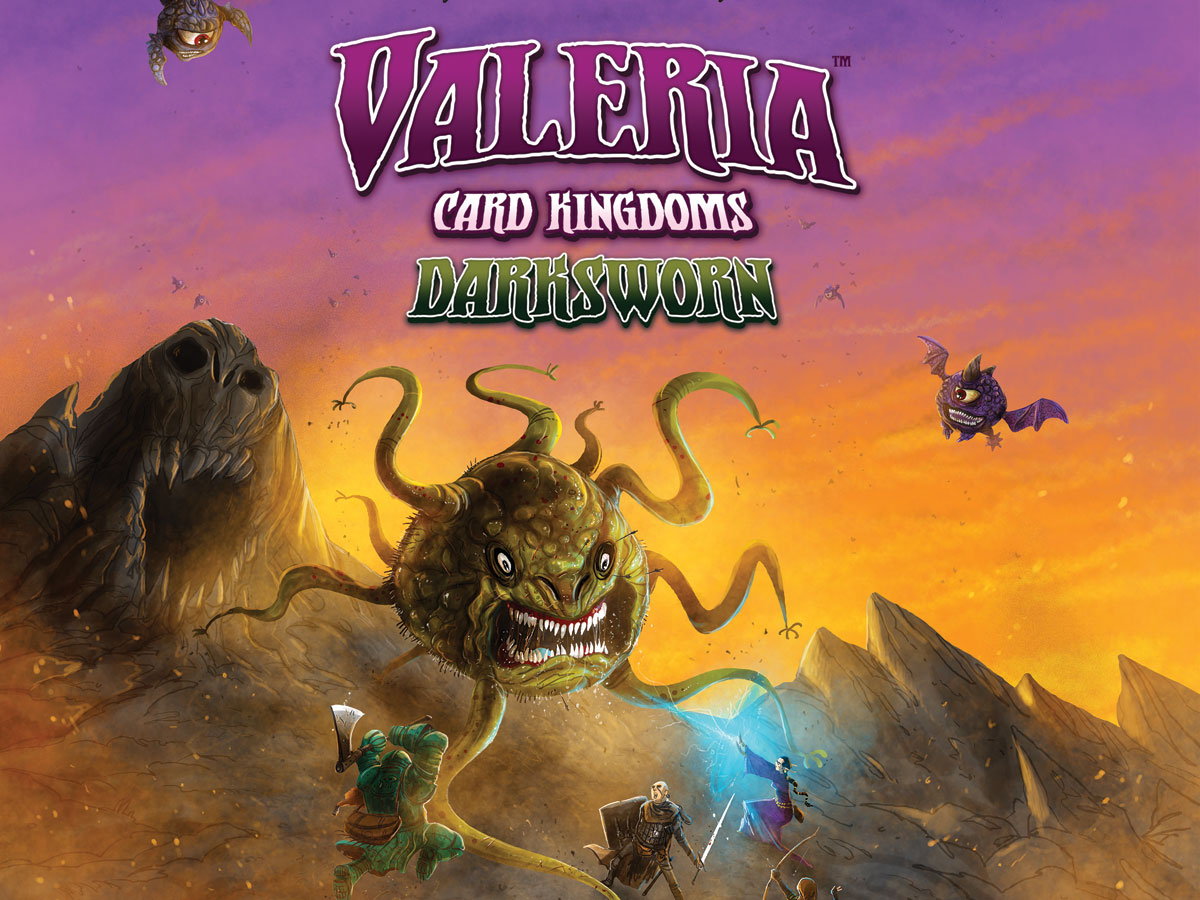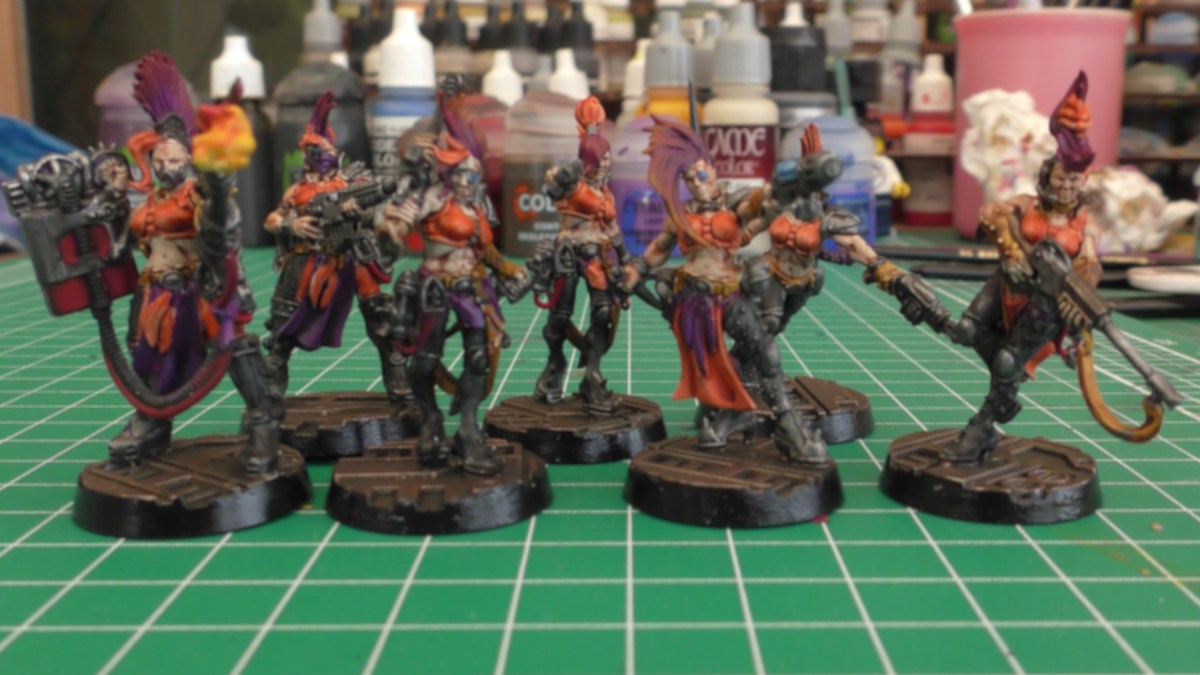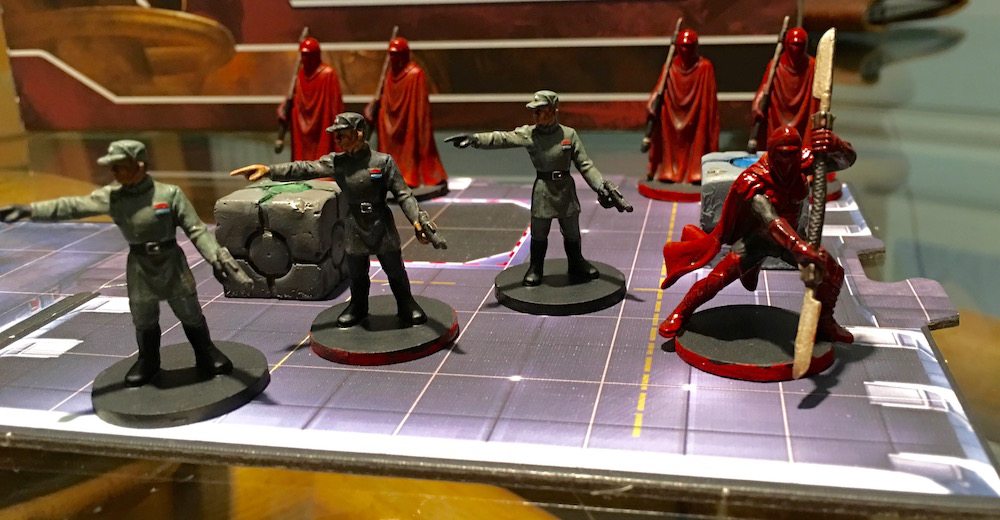Aquila has gifted the Dukes and Duchesses of Valeria with powerful orbs, because the monsters are approaching. Can you work together to hold them back and protect your home?
What Is Valeria: Card Kingdoms – Darksworn?
Valeria: Card Kingdoms – Darksworn is an expansion for Valeria: Card Kingdoms that adds a cooperative campaign; you will need a copy of the base game in order to play. It’s designed for 2 to 5 players, ages 14 and up, and takes about 60–120 minutes to play. It’s currently seeking funding on Kickstarter, with a pledge level of $29 for a copy of the game. There are also pledge tiers available for the second edition base game (without Darksworn) or both; a lot of the VCK expansion material that has been out of print will also be available as add-ons, and if you own the first edition you can get the new components as well. I noted that the base game could probably be played by experienced kids as young as 8, and the same may be true of the Darksworn expansion, particularly because it is cooperative so more experienced players could assist them.
Valeria: Card Kingdoms – Darksworn was designed by Isaias Vallejo and published by Daily Magic Games, with illustrations by Mihajlo “The Mico” Dimitrievski.
New to Kickstarter? Check out our crowdfunding primer.

Valeria: Card Kingdoms – Darksworn Components
Note: My review is based on a prototype copy and a Tabletop Simulator module, so it is subject to change and may not reflect final component quality.
Darksworn includes several “books” that you play through in order as a campaign, and each one has a varying number of cards—some even include small sheets of cardboard tokens to punch out. I won’t list the specific components in each book to avoid spoilers. It also includes a Dungeon Delve book. The physical prototype only included the first three Darksworn Saga books.
Here’s what comes in the game:
- Story board
- Aquila board
- 5 Number tiles
- 5 Wall tiles
- 5 Achievement tokens
- 6 Darksworn Saga books
- Dungeon Delve book
- 5 Reference cards
- 5 Explorer cards
- 9 Shade Monster cards
- 12 Blessing cards
- 1 Tuck box
As with the other games in this series, the artwork is by The Mico and fits with the rest of the titles. The “books” are decks of cards that are made to look like a book (with a front and back cover), and inside are several cards that look like pages that you flip through, as well as other cards that will be used in other ways. The books also include pages that tell the story, explaining the tasks you will be working on as well as the new monsters you will face. The two boards are primarily used to lay out the cards, but have some nice touches just to make them visually interesting and remind you about where cards should be placed.
It’s hard to say much more about the specific components that are included in the books, but there are some small tokens that come into play as you work your way through the books. The tuckbox is used to save your progress in the campaign in between games: there are some components that will carry over from one book to the next, so you store those in the box for the next play.
For those who own the 1st edition of Valeria: Card Kingdoms, there are a few changes in the second edition. For a $10 add-on, you can get the resource tracker boards.
- 5 Resource Tracker boards
- 50 “+10” Resource tokens
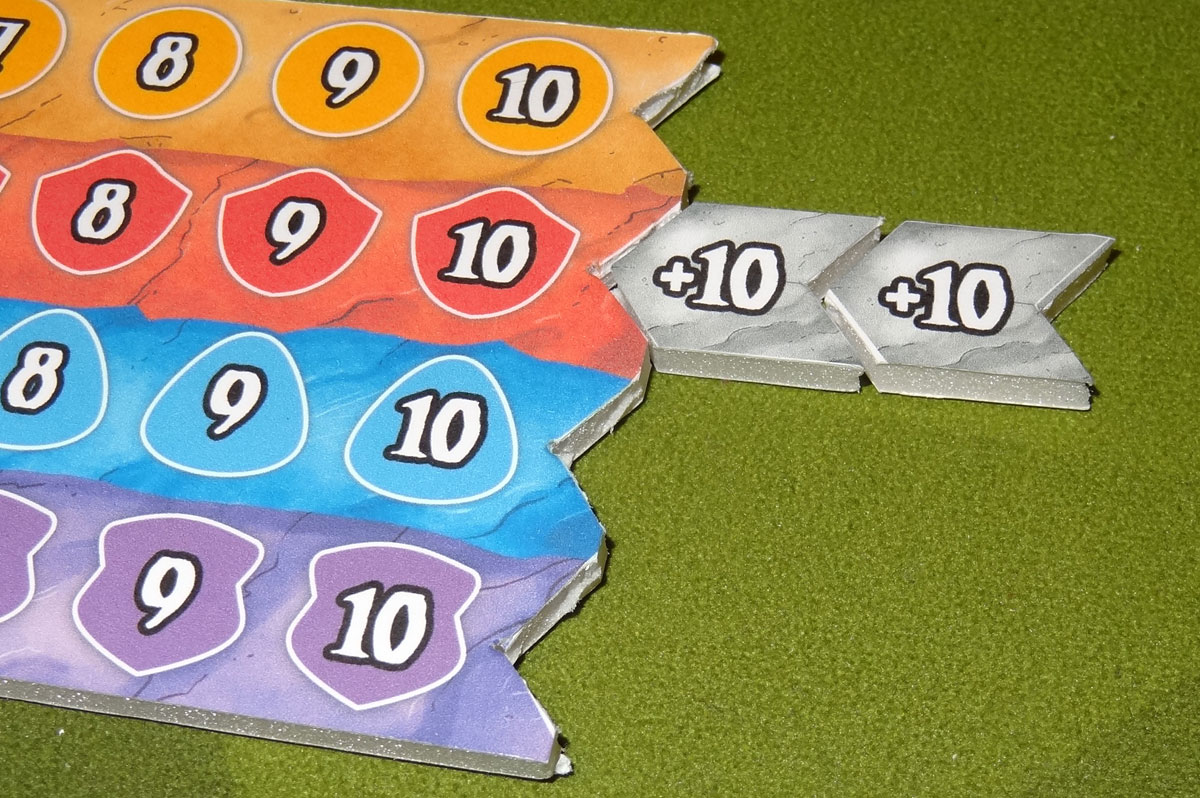
The tracker boards and +10 tokens are an alternative to the wood bits from the original base game: instead of collecting piles of gold, magic, strength, and victory tokens, each player has a board that tracks the four resources from 1 to 10, and then the +10 tokens are used if you hit the end of the track and need more. If you prefer using the piles of tokens in your first edition base game of Valeria: Card Kingdoms, of course, you’re entirely welcome to do so, but the tracker boards can be a bit more efficient, and the second edition of Valeria: Card Kingdoms will have fewer wooden bits. Note that the tracker boards are not part of the Darksworn expansion—it is specifically part of the 2nd edition Valeria: Card Kingdoms.
Also available for 1st edition owners are a $5 add-on pack of 16 cards. And for owners of either edition who want more storage space, you can get the bigger box that has a lot more room to store all the expansions.
How to Play Valeria: Card Kingdoms – Darksworn
You can download a copy of the rulebook here. Since the core of the game still uses the rules from Valeria: Card Kingdoms, I’ll refer you to my original review for that, and just outline what’s new in Darksworn here.
The Goal
In Darksworn, you will work together to play through the 6 books of the Darksworn Saga. Each book presents various tasks that must be completed before the monsters break through your defenses and destroy the city. Alternatively, you can play the Dungeon Delve, a standalone book that serves as a one-off game rather than a 6-session campaign.

Setup
From the base game (and expansions), choose 5 monster stacks, but remove the 5th player monster cards as well as the boss/warden cards. That should leave you with a deck of 20 monster cards—shuffle these together. Also, choose the set of citizens you will use for the game, as you would in a typical game of Valeria: Card Kingdoms. The number of cards in each citizen stack should be 2 plus the number of players, with a maximum of 6 cards per stack. Remove any extras.
Set up the center play area as following:
- At the top, put the story board and place the chosen book in the center book area of the board.
- Below that, place the 5 number tokens in a row.
- Set the monster deck to the right, and reveal one monster below each number token.
- Randomly draw 1 shade monster card per book level, and shuffle them into the monster deck.
- Place the 5 wall tokens in a row, one below each monster, with the “full wall” side showing.
- Lay out the citizen cards in two rows, lined up below the wall tokens.
- At the bottom, place the Aquila board. Shuffle the blessings deck and place it in the space on the right side of the board, and then reveal 3 blessing cards in the center of the board.

Give each player a resource board, an Explorer card, a Peasant, and a Knight. Give each player one of each resource token for tracking. Each player starts with 2 gold, 1 magic, and 1 victory point. (Remember: the resource boards are part of the 2nd edition base game, not part of the Darksworn expansion.)
Set the +10 tokens and achievement tokens (1 per player) nearby. Choose a random starting player and give them the dice.
Reveal the top card of the book—this may have additional setup instructions, as well as rules that are in effect during this book.
Gameplay
As with the base game, the general idea of the game is that the active player rolls the dice, which then activates everyone’s cards that match the numbers rolled (individual numbers and the sum), generating resources such as gold, magic, and strength. Magic can be used to supplement gold and strength, though there are times when you need to spend magic itself as well. You spend gold to recruit more citizens, adding them to your tableau so that you’ll have more chances to generate resources. You spend strength and magic to defeat monsters from the monster row, which are worth points and also give you rewards. So far, that’s all similar to the base game.
Here are a few key differences in Darksworn:
- Everyone starts with an Explorer card, which activates if the numbers rolled do not activate any cards in your tableau. They also activate if doubles are rolled.
- There are no Domains to purchase, and there are no Duke cards for secret end-game goals because it’s a cooperative game.
- While you do earn points for defeating monsters, points are another resource that can be spent on certain things and aren’t the ultimate goal of the game.
On your turn, you roll the dice and everyone gains resources based on the roll.
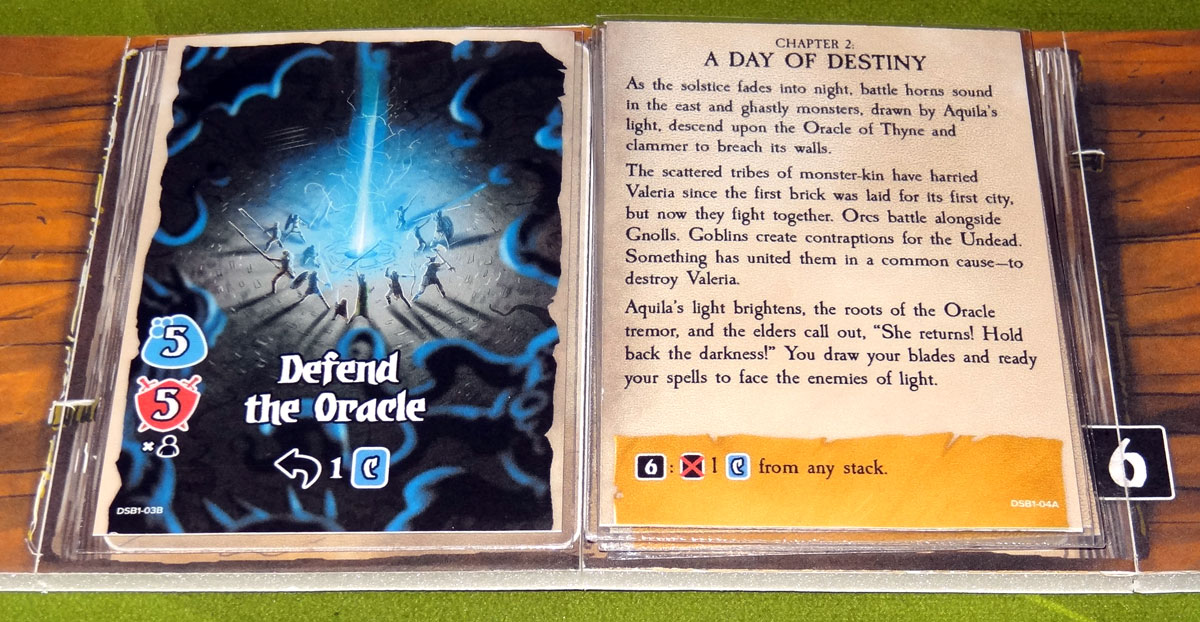
Then, you take 2 actions. Some of these are similar to the base game, some are new, and some have changed slightly:
- Slay a Monster: Spend the required resources, gain the rewards, and place the monster in the discard pile.
- Pray to Aquila: Use one of the blessing cards by paying the resource indicated (often points) to get the benefit, and discard the card. You may also spend 8 points to rebuild a new wall—this is printed on the board and is always available.
- Share Resources: Spend any amount of one resource; another player may gain half as many of one resource. (The spent resource and gained resource do not have to be the same.)
- Engage the Book: Spend the resources shown on the current page of the book, gain the reward, and place an achievement token on the page.

After you take your actions, there’s a Monster phase, activating the monsters in the columns matching the dice (both individual values and the sum). If a monster is activated, it attacks the column it’s in—if there’s a wall, it will damage it. (Each wall can withstand 2 attacks—you flip it over, and then you remove it.) If there are no walls, then the monster captures a citizen from one of the stacks below it, putting it into the oubliette area on the story board. Some monsters have special effects and may do other things when they are activated. Some shade monsters might trigger on a particular number, even if it doesn’t match the column they’re in.
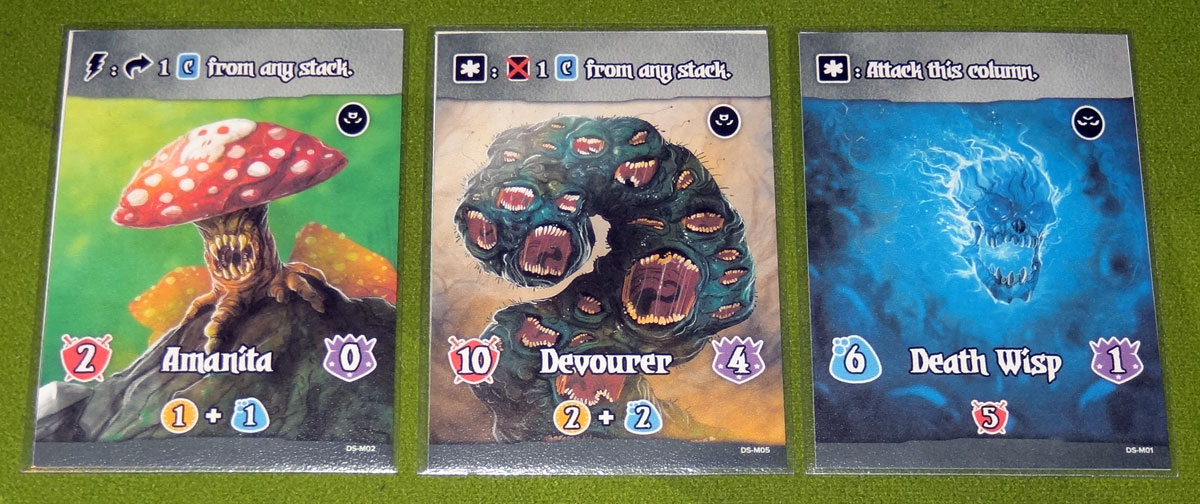
If you rolled a 6 (or the sum is 6), then the book activates: the bottom of the current book page indicates what will happen when the book is activated—and it’s always something bad.
At the end of your turn, check the current book task: if all of the achievement tokens have been placed onto the task, then you have completed the task and can flip the page. Then, refill any empty Blessing spots, and then refill any empty monster slots from left to right. Some monster cards have effects that trigger when the monster is put into play.
Pass the dice to the next player, who becomes the active player.
Game End
If you complete all of the tasks in the book, then you win!
If you need to banish or discard a citizen and there aren’t any valid options, then you lose. This can happen if a monster attacks a column that has no wall and no more citizen cards, for example.
When you complete a book successfully, it gives some instructions on which components should be saved when you continue to the next book.
Why You Should Play Valeria: Card Kingdoms – Darksworn
I’ll note that my plays of Darksworn were entirely done in Tabletop Simulator, because that was the only way I could play with people outside of my home. I had a group of three players that worked through the entire 6-book saga, and I also ran a 4-player game for the first book. Most of the players were already familiar with Valeria: Card Kingdoms, but I had one player who was entirely new to the game, and she didn’t have any trouble picking it up. If anything, Darksworn may even be easier to learn than the base game, because it leaves out domains and hidden goals, and since it’s a cooperative game everyone is discussing strategies as well.
Playing digitally meant that some things took a bit longer to do, and some things were quicker—shuffling card is a snap, but picking up your resource token and moving it over a few notches can take longer (especially if you accidentally pick up your entire resource board, something that’s unlikely to happen in real life). Our games usually took about 2 hours, though I know in one instance it was closer to 3 hours (perhaps including the setup time).
We really enjoyed making our way through the books, and the way that it would introduce new rules or components as we played. While Darksworn isn’t a legacy game—it can be reset and played again—you do get that fun surprise moment the first time through, when you open up a book and don’t know what’s coming on the next page. One thing you can tell without even opening the books is that some of them have a lot more cards in them, and so when we were playing the first time, we didn’t know what the game was going to throw at us: were there more tasks? Extra monsters? Cards for our tableaus?
The game doesn’t give you any sort of scoring chart: either you finish the tasks, or you lose because you lost too many citizens. It would be hard to make a universal scoring chart, though, because the difficulty level can vary quite a bit based on the mix of monsters you put into the deck. If all of your monsters are weak and easy to defeat, you may not have trouble protecting the citizens, but you also get smaller rewards for defeating them and it may take more turns overall to build up resources for the tasks in the book.

The difficulty can also vary quite a bit depending on how many times you roll a 6 during the game, because that triggers the book’s effect. When a monster is going to attack, you have some options: if there isn’t a wall there already, you could pray to Aquila to rebuild a wall. Or, if you have enough strength, you could defeat the monster, so that nothing attacks the column this turn. But with a 6, there’s almost no way to prevent the book from taking effect, other than one blessing in the deck that lets you manipulate the dice roll. Since the Tabletop Simulator module had a counter to track turns and 6s rolled, I know that one game we played took 32 turns, and we rolled 23 6s. It was brutal! A later game took 44 turns, but we only rolled 6s 17 times, and it felt a lot less tense. So the luck of the roll can also affect the feel of the game significantly. (Keep in mind, of course, that since you trigger attacks and effects based on the individual dice and the sums, 6s appear more often than you feel like they should, as the sum of two lower numbers.)
I will note that, even though the game felt challenging as we played it and we liked working out who should do what, we won all 6 books the first time we played and never lost (though we came quite close a few times). Generally during the game itself we were kept on edge, trying to complete the tasks while still managing monster attacks and protecting the citizens, and then when the game ended we realized that we still had a good number of citizens left in the stacks. Talking to the publisher about it, he remarked that he’s okay with a high win rate on the game; it seems like it’s intended to put pressure on you, but isn’t one of these games where you’re expected to lose most of the time. If you do want more of a challenge, the two ways to do that are to put in more of the higher-strength monsters, and also to remove 1 citizen from each stack during setup. Since I wanted to get through the whole campaign before my review, we opted to leave it at the standard difficulty level. All three players in my group agreed that Darksworn did a good job of creating a good amount of tension even when we did well; at least part of that was not knowing what was coming next in the book.
Turning Valeria: Card Kingdoms into a cooperative game has some interesting effects. The core of the game still feels the same, in terms of building up your tableau so you can get the needed resources for your goals. However, since it’s now cooperative, the dynamics change a bit. When you’re working on your own, it can be beneficial to spread out and try to cover as many numbers as possible because you only gain for your own tableau. But here, it might make sense to let one player recruit a lot of the same character to build up certain combos if it helps the whole team. The Explorers card that everyone starts with gives you resources when the dice roll don’t benefit you—but as you add more to your tableau, you could make the Explorers almost useless. Maybe it’s worth stacking up on fewer numbers, so that the Explorers trigger more often?
One of the changes here is that, because the monsters are capturing citizens from the stacks, you have to be careful about how many you recruit. Sure, the players could just hire up all of the citizens, but those citizens are also your defense against the monsters. Even if you have enough gold to recruit the last Warlord, maybe you need him standing there to protect the city!
The tasks in the book have different descriptions based on what’s happening in the story, but generally they require you to spend a lot of resources at once—and the further you progress in the story, the higher those costs get. Much of the game is spent figuring out how to accumulate enough resources to do the task without letting too many citizens get captured by monsters. If the task requires gold: do you spend gold to hire more citizens, hoping that will generate gold more quickly to complete the task? Or do you do the task first, but then miss out on building up your engine for future turns? Most of the books have a series of tasks, and you don’t know what you’ll need for future tasks.

The Aquila board is a new element, and this is primarily where you will be spending points. Most of the blessings require you to spend points, and will give you resources, return captured citizens, or even rebuild walls. In the base game, you were defeating monsters for points and that was the goal in itself, but now you’re battling to prevent the monsters from attacking, and so that you can earn points to spend on the blessings. It’s a neat way to take a mechanic from a competitive game and adapt it for cooperative play.
The 5th player in Valeria: Card Kingdoms was originally added during the first Kickstarter campaign, and the way it works is that the 5th player in turn order (the one sitting to the right of the active player) does not collect any resources from the die roll, so players take turns sitting out. It’s intended to prevent resources from becoming too abundant, but it can feel bad when the numbers you want come up on the turn that you’re sitting out. I think it’s an okay workaround, but I think I generally prefer to play Valeria with 4 players at most, and the same is probably true of Darksworn.
Darksworn takes Valeria: Card Kingdoms in a different direction from the previous expansions. I wasn’t sure at first how they’d turn a competitive game into a cooperative game, but it works! If you have players in your group who prefer cooperative games, Darksworn lets you enjoy the dice-rolling, tableau-building systems from the original game, while working together toward a common goal. Also, if you’re drawn to the lore of Valeria, which has been gradually laid out over the various different games (including Quests of Valeria and Villages of Valeria), then you’ll appreciate the way that there’s a lot more narrative incorporated in this campaign.
For more information or to make a pledge, visit the Valeria: Card Kingdoms – Darksworn Kickstarter page!
Click here to see all our tabletop game reviews.
![]() To subscribe to GeekDad’s tabletop gaming coverage, please copy this link and add it to your RSS reader.
To subscribe to GeekDad’s tabletop gaming coverage, please copy this link and add it to your RSS reader.
Disclosure: GeekDad received a prototype of this game for review purposes.
